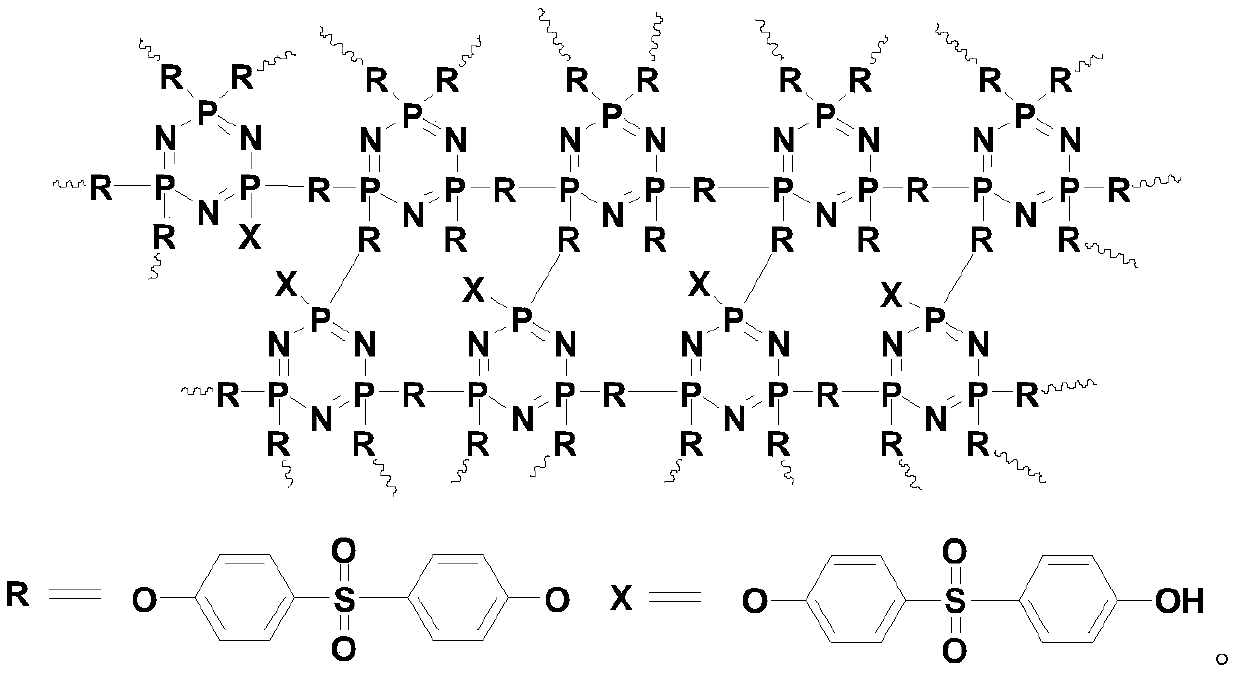Polyethylene terephthalate-1, 4-cyclohexanedimethanol ester double-base synergistic flame-retardant composite material and preparation method thereof
A technology of polyethylene terephthalate and cyclohexanedimethanol is applied in the field of polyethylene terephthalate-1,4-cyclohexanedimethanol composite materials, and can solve the problem of polymer The mechanical and mechanical properties of the matrix or reinforcement material are decreased, and the compatibility is poor, so as to achieve the effects of excellent interfacial compatibility, strong thermal insulation and oxygen barrier ability, and strong carbon-forming ability.
- Summary
- Abstract
- Description
- Claims
- Application Information
AI Technical Summary
Problems solved by technology
Method used
Image
Examples
Embodiment 1
[0030] A method for preparing a polyethylene terephthalate-1,4-cyclohexanedimethanol double-base synergistic flame-retardant composite material, comprising the following steps:
[0031] S1. Add 90kg of polyethylene terephthalate-1,4-cyclohexanedimethanol, 2.5kg of reactive phosphaphenanthrene, 2.5kg of reactive polyphosphazene, and 5kg of ethylene-acrylic acid butyl Ester-glycidyl methacrylate terpolymer and 0.5 kg of bis(2,4-dicumylphenyl)pentaerythritol diphosphite were dried at 80° C. and mixed to obtain a mixture. Drying time is 1-4h, dry to no obvious moisture;
[0032] S2. The mixture in step S1 is blended and extruded through a twin-screw extruder at 215-245° C., and then cooled to room temperature, followed by traction and pelletizing to obtain polylactic acid, phosphaphenanthrene and polyphosphorus Nitrile double base synergistic flame retardant composite material.
[0033] The structure of the reactive type phosphaphenanthrene is as follows:
[0034]
Embodiment 2
[0036] The difference from Example 1 is that in step S1, 2 kg of the gas phase flame retardant is used, and 2 kg of the condensed phase flame retardant is used.
Embodiment 3
[0052] A method for preparing a polyethylene terephthalate-1,4-cyclohexanedimethanol double-base synergistic flame-retardant composite material, comprising the following steps:
[0053] S1, 80kg of polyethylene terephthalate-1,4-cyclohexanedimethanol, 2kg of reactive phosphaphenanthrene, 2kg of reactive polyphosphazene, 5kg of polyethylene grafted methyl Glycidyl acrylate and 0.5 kg of bis(2,4-dicumylphenyl)pentaerythritol diphosphite were dried at 75° C. and mixed to obtain a mixture. Drying time is 1-4h, dry to no obvious moisture;
[0054] S2. The mixture in step S1 is blended and extruded through a twin-screw extruder at 215-245° C., and then cooled to room temperature, followed by traction and pelletizing to obtain polylactic acid, phosphaphenanthrene and polyphosphorus Nitrile double base synergistic flame retardant composite material.
[0055] The structure of the reactive type phosphaphenanthrene is as follows:
[0056]
PUM
 Login to View More
Login to View More Abstract
Description
Claims
Application Information
 Login to View More
Login to View More - R&D
- Intellectual Property
- Life Sciences
- Materials
- Tech Scout
- Unparalleled Data Quality
- Higher Quality Content
- 60% Fewer Hallucinations
Browse by: Latest US Patents, China's latest patents, Technical Efficacy Thesaurus, Application Domain, Technology Topic, Popular Technical Reports.
© 2025 PatSnap. All rights reserved.Legal|Privacy policy|Modern Slavery Act Transparency Statement|Sitemap|About US| Contact US: help@patsnap.com



